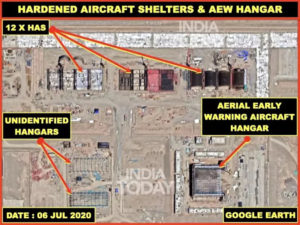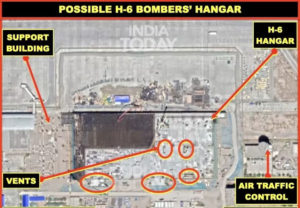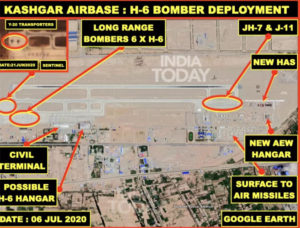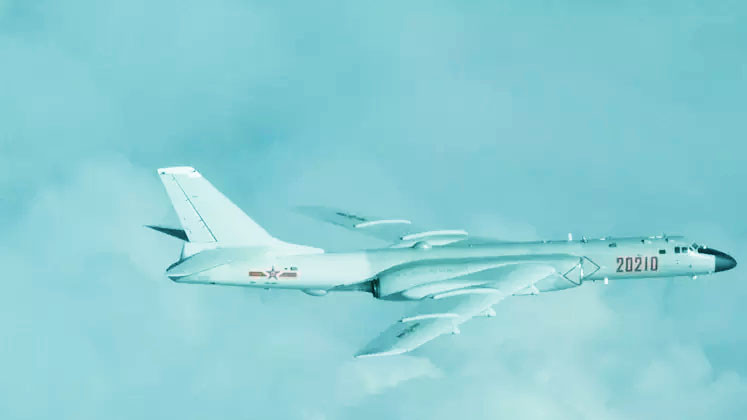China’s Kashgar Airbase: Underground Vaults Hint At Nuclear Facilities, H-6 Bombers Seen Since Early June
2 August, 2020
India Today’s OSINT team analysed satellite images from Google Earth over the last months to study the changes at China’s Kashgar air base. Satellite images show construction of an underground vault months before the India-China standoff started in Ladakh .
An underground vault construction in China’s Kashgar airbase months before the India-China standoff started in Ladakh shows how People’s Liberation Army Air Force (PLAAF) has been ramping up infrastructure for air power, satellite images analysed by India Today’s OSINT team suggest.
The underground construction that could be used to conceal nuclear warheads is among the many strategies adopted by China taking an aggressive stand against India including the deployment of its H-6 bomber aircraft in Kashgar. Thr H-6 bomber aircraft was recently part of war games by in the South China Sea.
The Kashgar airbase is 475 km away from the Karakoram Pass and is seen as a direct deployment against India.
From the Finger 4 area of the Pangong Lake that has been the biggest flashpoint Kashgar is 690 km. The distance of Daulat Beg Oldie, India’s airfield in eastern Ladakh at more than 16,000 feet the distance to Kashgar is 490 km.
India Today’s OSINT team analysed satellite images from Google Earth over the last eight months to study the changes at the airbase.
The Kashgar airport has been a dual use airport put to civilian and military use like every other border airport.

These vaults being under the Hardened Aircraft Shelters (HAS) can provide protection from direct attack as well as deny satellite/aerial observation during preparation for use of the weapons.
The construction of the underground vault started late last year, much before the India-China standoff in Ladakh, the satellite imagery indicates.
The approximate depth is 8m and a square portion under possibly two of these shelters is further dug to almost 15m depth.
In an image of November 28, 2019 some work at the air field with additional digging and 12 hardened aircraft shelters.
A former Indian Air Force officer who has been incharge of the western air command that is responsible for air operations in Ladakh as well, said earlier the aircraft were parked in the open at Kashgar.
“If shelters and underground facilities are there, then that has to be recent development. If they need to cover the aircraft and have underground facilities one can sense they are trying to keep something secret,” the officer who did not wish to be identified said.
The underground vaults are weapons storage and security systems built under the floors of protective aircraft shelters.
These are built to avoid carriage of nuclear weapons from the weapon storage area or igloos to the aircraft which otherwise would require protection party during even the small movements.
These are invariably automated to protect and safeguard nuclear weapons from unauthorised use and mishandling.
The vaults generally contain two to four weapons and can be fed to the same hardened shelter or nearby shelter through automated conveyor belt system.
Sources said such underground vault seems to suggest the presence of secret weapons or nuclear warheads.
China has always been harping upon its ‘No First Use’ (NFU) nuclear policy but western analysts have always doubted Chinese NFU policy in almost all their assessments. Recently Federation of American Scientists had accepted that Chinese Air Force may have a role to play in its nuclear policy and execution.
Hardened Aircraft Shelters With Possible Underground Vault System

There are twelve hardened aircraft shelters (HAS) that are clearly visible on the Eastern end of the runway as on July 6.
A large hangar possibly for an aerial early warning (AEW) aircraft is also being constructed South of the HAS.
The work on this started back in February 2020, according to a comparative analysis of the satellite imagery of the airbase.
Some, possible construction, activity is observed under tarpaulin cover in this square portion for over two months indicating specialised secretive work.
The later construction over this area gives out certain signatures that indicate a possible construction of underground vault system at this location.
Earlier, some underground work was also observed at the tarmac near Western end of taxiway. The purpose of this could not be identified yet.
Deployment of H-6 Bomber Aircraft

The deployment of six H-6 bombers arriving at Kashgar was noticed on June 4 amid the India-China standoff in Ladakh. By then three rounds of Corps Commander level meeting had taken place to find a resolution to the tussle that started early May triggering skirmishes along with troops and arms build up by both sides. It’s been 90 days since the standoff started in early May and after five rounds of top level military talks still the disengagement is not complete.
The deployment of H6 bomber aircraft has been routinely observed at in least at four airbases in the Western Theatre Command responsible for defences against India from Karakoram Pass to Arunchal Pradeh in the East.
The deployments until now although irregular indicate the capability and intentions of the PLAAF.
The Kashgar airbase has had a regular deployment of JH-7 and J-11 aircraft along with surface to air missiles since a long time but the H6 bombers were an addition.
It’s interesting that the hangars for these aircraft started to come up in January this year as is seen in the satellite images reviewed by India Today.
It is clear that preparations started for their deployment earlier, much before the standoff but the aircraft were brought in once the tension peaked.
Armbed Bombers

The satellite images show that two of the H-6 bomber aircraft have their nose, engines and front fuselage covered with red tarpaulins. The same aircraft have also been seen carrying two missiles each under its wing pylons.
This indicates very strongly that the aircraft would be carrying more bombs and or missiles under the belly or inside the bomb bays in lower fuselage.

There are twelve JH-7 and four J-11 fighter aircraft observed at the Eastern end. The JH-7 aircraft are observed carrying four missiles each and J-11 fighters are carrying two each.
The H-6 Bomber Shelter

A large shelter of 150m width and 75m length is being constructed next to the civil terminal building.
The construction is similar to that of HAS construction compared to the digging into the ground.
The historical imagery indicates that some kind of underground work has been undertaken with at least two vents of 8m X 2m being seen at floor level.
A correct assessment of this shelter can be made probably after a month or two when more imagery is available.
The Strategic Transporter Y-20 Chubby Girl
China PLAAF’s latest acquisition the Y-20 strategic transporter was observed on commercial satellite imagery on June 21.
Two Y-20 aircraft were observed at the Western end of the runway parked side by side. They have not been observed again throughout the month.
The temporary deployment could be a trial for its use in this extreme weather conditions possibly testing weight carrying capacity.
UAV Deployment
The Winglong-1 UCAV (unmanned combat aerial vehicle) was seen deployed at Kashgar since end of 2014 along with a fabric shelter.
The fabric shelter along with four satcom vehicles and ground control system vehicles have been observed in the latest images.
However, no UAV has been observed suggesting that they are being flown regularly to gather information.
Courtesy: Opera News/indiatoday
Source: indiatoday.in

